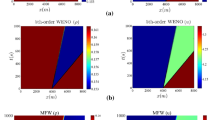Abstract
Traffic jams that appear without distinguishable reason is called phantom traffic jam. To study this phenomenon, macroscopic modelling using the second-order Payne-Whitham equation was adopted. In this article, the staggered conservative scheme applied on a staggered grid was implemented to solve the equation. Using this scheme, different behavior of a perturbed equilibrium solution was simulated; it might either decay or grow, depending on the critical threshold parameter. When unstable, a small perturbation was amplified into a local peak of high traffic density. This type of traveling wave is called a jamiton. On a circular road of a certain length and with a fixed number of vehicles, the growing process of these traveling jamiton waves was simulated. The shape and propagation speed of these numerical jamitons are shown to confirm the analytical formulas. A good understanding of this phenomenon may support decision-makers and engineers to determine the judicious selection of speed limits of a certain road section.











Similar content being viewed by others
References
Flynn, M.R., Kasimov, A.R., Nave, J.C., Rosales, R.R., Seibold, B.: Self-sustained nonlinear waves in traffic flow. Phys. Rev. E 79(5), 056113 (2009)
Jin, W., Zhang, H. M.: Solving the payne-whitham traffic flow model as a hyperbolic system of conservation laws with relaxation. Transportation Science (2001)
Orosz, G., Wilson, R.E., Szalai, R., Stépán, G.: Exciting traffic jams: Nonlinear phenomena behind traffic jam formation on highways. Phys. Rev. E 80(4), 046205 (2009)
Pudjaprasetya, S., Magdalena, I.: Momentum conservative scheme for dam break and wave run up simulations. East Asian J. Appl. Math. 4(2), 152–165 (2014)
Que, Y. T., Xu, K.: The numerical study of roll-waves in inclined open channels and solitary wave run-up. Int. J. Numer. Methods Fluids 50(9), 1003–1027 (2006)
Rascle, M.: An improved macroscopic model of traffic flow: derivation and links with the lighthill-whitham model. Math. Comput. Modell. 35(5-6), 581–590 (2002)
Seibold, B., Flynn, M. R., Kasimov, A. R., Rosales, R. R.: Constructing set-valued fundamental diagrams from jamiton solutions in second order traffic models. arXiv:1204.5510 (2012)
Stelling, G. S., Duinmeijer, S. A.: A staggered conservative scheme for every froude number in rapidly varied shallow water flows. Int. J. Numer. Methods Fluids 43(12), 1329–1354 (2003)
Stern, R. E., Cui, S., Delle Monache, M. L., Bhadani, R., Bunting, M., Churchill, M., Hamilton, N., Pohlmann, H., Wu, F., Piccoli, B., et al.: Dissipation of stop-and-go waves via control of autonomous vehicles: Field experiments. Transp. Res. Part C: Emerg. Technol. 89, 205–221 (2018)
Sugiyama, Y., Fukui, M., Kikuchi, M., Hasebe, K., Nakayama, A., Nishinari, K., Tadaki, S.i., Yukawa, S.: Traffic jams without bottlenecks—experimental evidence for the physical mechanism of the formation of a jam. J. Phys. 10(3), 033001 (2008)
Suijs, L., Wismans, L. J. J., Krol, L., van Berkum, E. C.: Phantom jam avoidance through in-car speed advice. Transp. Res. Procedia 8, 227–236 (2015)
Whitham, G.: Some comments on wave propagation and shock wave structure with application to magnetohydrodynamics. Commun. Pure Appl. Math. 12(1), 113–158 (1959)
Acknowledgments
Financial support from Institut Teknologi Bandung Research Grant with contract number 91j/I1.C01/PL/2019 is greatly acknowledged.
Author information
Authors and Affiliations
Corresponding author
Additional information
Publisher’s Note
Springer Nature remains neutral with regard to jurisdictional claims in published maps and institutional affiliations.
Appendix
Appendix
In this Appendix, the proof of two theorems will be described.
Theorem 4
If the traveling wave solution is in a form of a left shock, then m > 0, du/dη > 0, and dρ/dη < 0 for \(\eta \in \mathcal {D}\).
Proof
Assuming the shock as a left shock means that we assume (12) to be true. From Eq. 12 we have (u−− s) > c−, which then using Eq. 21 yield
The last inequality of Eq. 62 comes from the fact that both ρ−, and c− are positive. Further, since p(ρ) is an increasing convex function, we have \(p^{\prime }(\rho )>0\) and \(p^{\prime \prime }(\rho )>0\), resulting
which mean that ρc is an increasing function of ρ. Across the shock (9) holds which gives us ρ+u+ − ρ−u− = s(ρ+ − ρ−) or
in which the last inequality comes from Eq. 12. Hence, we obtain ρ+c+ > ρ−c−, and since ρc is increasing, we conclude that ρ+ > ρ−, i.e. the downstream state is higher than the upstream state of the shock,
Further, along the continuity interval \(\mathcal {D}\), the function ρ(η) is decreasing, and so a typical profile of a left shock (jamiton) is illustrated in Fig. 12. Furthermore, from relation (6), we can conclude u+ < u−, so du/dη > 0 on \(\mathcal {D}\), and this completes our proof. □
Theorem 5
traveling wave in a form of a right shock is mathematically inconsistent.
Proof
Assuming a right shock occur, and arguing in a similar way as in the previous theorem, Eq. 13 gives us
-
(i) m < 0,
-
(ii) u− > u+, ρ− > ρ+,
-
(iii) du/dη > 0, dρ/dη > 0.
In case 2 (u+ + c+ < s < u− + c−), we have (13) which can be re-written as
Rewriting (7) using (6) and its sign follows from (iii) yields
Since m < 0 from (i), we get mρ < 0 and also m − ρc < 0, than we may conclude that Eq. 66 is satisfied if
Denoting
we conclude that g(ρ) is decreasing, since m < 0 and \(\tilde {u}(\rho )\) is decreasing. Thus, g(ρ−) > g(ρ+) from (67), and the decreasing property of g gives us the conclusion that ρ− < ρ+, which contradicts (ii). Therefore, a right shock solution must be mathematically inconsistent. □
Rights and permissions
About this article
Cite this article
Malvin, N., Pudjaprasetya, S.R. Staggered Conservative Scheme for Simulating the Emergence of a Jamiton in a Phantom Traffic Jam. Int. J. ITS Res. 19, 128–140 (2021). https://doi.org/10.1007/s13177-020-00229-y
Received:
Revised:
Accepted:
Published:
Issue Date:
DOI: https://doi.org/10.1007/s13177-020-00229-y





